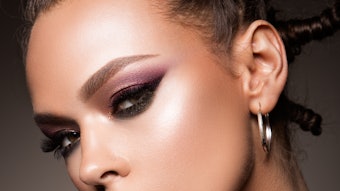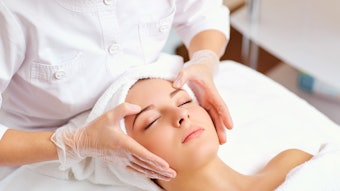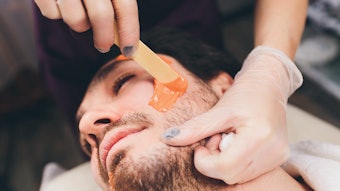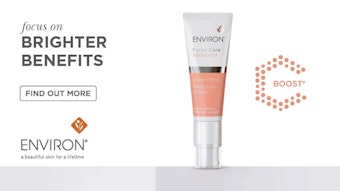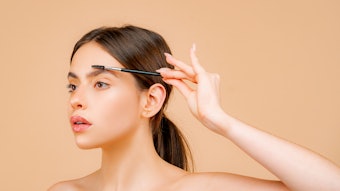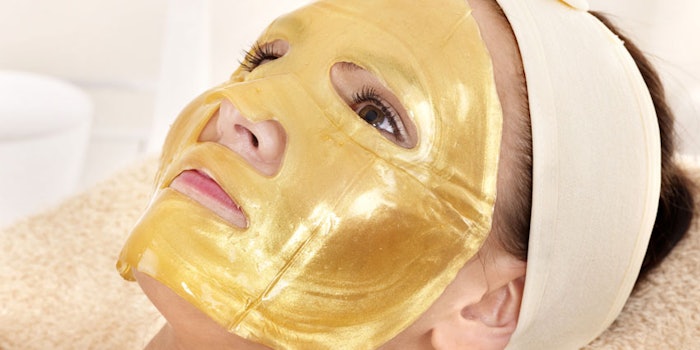
Masks are a staple for an esthetician’s toolbox. They are most commonly used as the last step in a treatment protocol to deliver vital nutrients, rehydrate, exfoliate and/or purify the skin. Below are five types of masks that clients will love.
1. Magnetic Masks
Magnet masks are effective, but they don’t work by just rubbing your clients’ face with a magnet. The mask itself looks like a purifying mud mask, and many people believe the magnet is meant to pull everything out of the pores. Although it does purify, it does much more.
Negatively charged metal particles such as iron make up the mask. A positively charged magnet is then traced over the face (without contact) to remove it, creating a low-grade of electromagnetic current.This reaction has several benefits: increased circulation, boosted cellular activity and reduced inflammation. The result is a more youthful, rejuvenated appearance. Word has it that Cleopatra slept with a magnetic amulet on her head to maintain her youthful appearance. Magnets have also been used in alternative medicine for several years, most commonly for pain relief and healing.
2. Sheet Masks
Sheet masks have been widely used in Korea for ages. The sheets allow for better penetration of the active ingredients in to the skin with its occlusive action. They are face-shaped masks that are easily applied and left on the skin for product absorption. They are usually left on for about 10-20 minutes, although some people sleep in them.
Sheet masks are soaked with beneficial ingredients such as hydrolyzed collagen, hyaluronic acid, skin lightening agents, vitamins and/or minerals. Hydrolyzed collagen is probably the most widely known; it rejuvenates skin, gives an immediate glow and plumps the skin. Just to be clear, collagen is too large of a molecule to penetrate the skin. Hydrolyzing is a chemical process that helps break down the collagen into smaller particles. These particles are broken down to amino acids that aid in maintaining and rebuilding heathy proteins in the skin but do not replace lost collagen.
There are several types of sheets used. Bio-cellulose masks are hydrophilic, meaning they love water, so are especially good for hydrating the skin. They adhere to the skin nicely and don’t dry out, allowing for better product absorption. Bio-cellulose is also used as an occlusive dressing in medicine to heal and soothe burns.
Hydro-gel masks, also hydrophilic, blend serums with gelatin to create a thin cooling film that is hydrating and occlusive but are thinner and can tear more easily.
Non-woven fiber masks are less expensive, but can dry out quickly and do not adhere to the face as well. Sheet masks are a great add-on to a facial, especially for the immediate gratification effect.
3. Occlusive Masks
Occlusive masks, for the most part, can be used on all skin types and conditions but are particularly effective for sensitized skin. Acne, rosacea and post-resurfacing clients can benefit greatly from the soothing, healing, and cooling properties associated with these masks.
Packed full of essential vitamins and minerals, alginate and seaweed are the most commonly used bases for these types of masks. Alginate promotes blood circulation, reduces redness and creates a lifting effect. Seaweed is anti-inflammatory and increases skin’s metabolism. They both have soothing and anti-aging benefits. A major benefit of occlusive masks is the ability to lock in moisture and promote product penetration. They come in a powder form and are mixed with water turning it into a rubber-like consistency. The mask is applied to the entire face with a large spatula (even the lips and eyes can be covered) and left to dry for 10-20 minutes while molding to the shape of the face. Once dry, it can be easily lifted off, leaving the skin looking more vibrant and refreshed.
4. Enzyme Masks
Enzyme masks are mainly used for exfoliation, although they have several other benefits. Enzymes are catalysts that speed up natural biological processes, in the case of topical enzymes in skin care, they eliminate dead skin cells on the surface by dissolving keratin proteins. They can range from mild to strong depending on the ingredients and the amount of activity they create when in contact with the skin.
Fruit and vegetable enzymes are good for all skin types but they have varying properties. Some are better for dry, sensitive skin, while others are better for thick, oily skin. Papaya (papain) is probably the most commonly used since it is gentle and delivers antioxidants while brightening the skin. It is most commonly used for dry, sensitive, dull, and photo-damaged skin.
Pineapple (bromelain) contains high amounts of vitamin C and works well to reduce swelling and inflammation. Pumpkin enzymes can be more potent, as they contain natural levels of alpha and beta hydroxy acids, breaking apart bonds that anchor cells together to allow for a deeper exfoliation. Pumpkin also contains potent antioxidants including beta-carotene, a derivative of vitamin A.
Pancreatic enzymes are found in the body and are important for food digestion. When used topically, they work to dissolve the keratinized proteins on the surface of the skin like the other fruit or vegetable derived enzymes. There are several other enzymes used in skin care derived from Japanese mushroom, the aloe vera plant, and several fruits including acai berry, blueberry, apple and many more. Enzymes can come in the forms of peels or gommages, but are most commonly found in a powder form that are mixed with liquid and are activated by steam.
5. Purifying Masks
Let’s face it, everyone needs some purifying. There are several types of purifying masks used to absorb excess sebum, draw out impurities and fight breakouts. The most commonly used purifying masks include minerals such as clay, mud and/or charcoal. These ingredients have the ability to naturally detoxify the skin and are antibacterial. They can also micro-exfoliate, meaning they attach to dead skin cells leaving the surface of the skin softer and smoother. Clay has been used in skin care since ancient times.
Bentonite, one of the most commonly used clay bases, was discovered in rock formations and was soon after being used to purify and rejuvenate that skin. Mud masks became popular when people starting bathing in the dead sea and appreciated benefits including softer, more vibrant skin. Activated charcoal has recently become one of the most sought-after masks due to its ability to absorb toxins, but don’t let the scary videos on the internet scare you. Make sure the mask is from a reputable company and if it hurts while pulling it off the skin, that’s probably not good.


